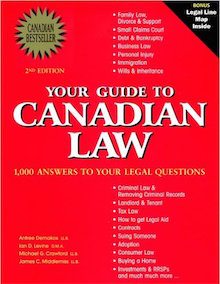The general understanding of the legal and court system in Canada is that once a person is arrested and charged, there is eventually a trial. It is at this trial that the most familiar outcomes for the public are determined: guilty or innocent. But while a verdict of guilty with appropriate punishment, or an acquittal with the accused resuming normal life are the two most well-known outcomes, they are not the only ones that can take place in a court of law.
There are a few other decisions that a judge can make, that can “bypass” the verdict a jury may reach. One of those decisions is known as a stay of charges or, legally, stay of proceedings. We are going to take a better look at this less common legal decision, and what it means for the people who receive it.
The Arrest & Charges
We’ll take this step-by-step to get a better understanding of this process. An event occurs in which there is a firm belief or outright evidence of a breach of the law. The police respond, and if they feel there is cause for it, an arrest is made, with charges applied to the person who has committed the act.
The arrest procedure should be familiar to most people, even if the knowledge is gleaned second-hand from television. The person arrested is brought to a police station, fingerprints are taken, photographs are taken, and the entire arrest process is documented, and entered into the Canadian Police Information Centre (CPIC) database.
Depending on the nature of the act, the charges may be criminal, and if they are criminal charges, that may mean there will need to be a resolution in court with a verdict from a judge or jury. Circumstances may dictate that bail needs to be paid if the defendant wishes to continue with a normal, daily life until the trial begins. If the crime is very serious, such as murder, then bail is usually not an option, and the defendant must await trial in prison.
The Trial
The trial is where the stay of charges takes place. It is where the expected legal proceedings can veer in an unexpected direction. The stay of charges, or stay of proceedings, is a very rare, very specific decision by the court officers, such as the lawyers or judge—not the jury—to halt the trial that is currently underway. In other words, the trial and the need to reach a verdict is “put on hold.”
A stay of charges effectively means that the trial is not going to go forward, and that, at least for the moment, there is going to be no further court action to seek a verdict. However, it is crucial to note that a stay of charges is not a cancellation. Even if the current trial has been discontinued, the charges themselves are, in a sense, “still in play.”
At any time, a court may change its mind, and decide to continue with a new trial, in order to finally get resolution on a verdict of guilty or not guilty. It is only if the charges are wholly withdrawn that a person who has been arrested can be considered “clear,” with no further expectation of a future trial or verdict.
Of course, a stay of charges is extremely rare, and this isn’t something that happens every day in Canadian trials. So, what would have to happen in order for a stay of charges to occur? And why decide to go with a stay of charges, rather than simply withdraw a case if the decision is to cancel a trial anyway?
The Types of Stay
A stay of charges can arise from two causes. The first is a “Charter Stay” that is called for when it is believed that if the current trial proceeds, the Charter Rights of the accused may be violated in some way. The second type is known as the “Crown Stay,” and this is what happens when the lawyers and judge reach a consensus and decide that it may be better to halt the trial, rather than proceed. A Crown Stay can be called for a number of different reasons, as opposed to the Charter Stay, which is specifically focused on preventing a violation of rights for the accused.
Why You Might Receive a Stay
The biggest difference between a stay of charges and having charges withdrawn is the intent. For example, the court discovers that someone was arrested because he bears a resemblance to another person who is wanted for a criminal act, but within a few hours, the actual suspect is apprehended. Any charges laid against the first person will be dropped and withdrawn because he is not the suspect being pursued.
On the other hand, a stay of charges can occur due to various legal complications. As one example, a lawyer may have a witness who, before the trial begins, agrees to provide a testimony in court that will confirm the guilt of the accused. However, once in court, the witness now becomes “hostile,” which is to say that the witness is no longer cooperating and answering the questions in an expected way. A typical example of a witness turning hostile is when an abused spouse or partner has a change of heart in the days leading up to a trial and decides not to provide the previously agreed upon, honest testimony, in an attempt to prevent the abusive partner from being prosecuted and given a prison sentence.
In such instances, a lawyer may put into motion a stay of charges, simply because with a currently hostile witness, on whose testimony a conviction was reliant, a smooth trial process is now in jeopardy. It is better at this point to enact the stay of charges, and keep the actual criminal charges “live” to be addressed at a later date if it is possible. This stay may require talking to the witness again, or, in some cases, may even result in new charges being applied with the passage of time, in which case the previous charges will be added to the new ones.
How a Stay Protects Your Rights
On the other hand, a stay of charges may occur because it has become clear that somewhere along the typical, legal proceedings, something may have gone wrong. And to continue the trial in such a manner would actually violate the rights of the person being accused of committing a crime.
One example of such a circumstance where a Charter Stay may be called for is in the handling of evidence. Someone might be accused of committing a crime, such as breaking and entering, theft or burglary. One of the reasons that charges may be laid is because the evidence was gathered at the scene including fingerprints that are supposed to be a match. However, if an accident occurs and the vehicle carrying the evidence, including the fingerprint samples, is damaged and the evidence is lost or compromised, then this may be grounds for a stay of charges.
If an accused is going to trial, and there is any doubt about the evidence gathering and preservation process, a Charter Stay may be invoked to protect the accused from an improper prosecution. Every Canadian citizen is entitled to a full trial with proper legal and investigative procedure observed. If these rights and protections aren’t adequately represented, then there’s a question of whether the trial is being properly conducted, and whether any verdict rendered through a trial with improper procedures is valid.
In these cases, it makes better sense to move for a stay of charges, and make sure that everything is appropriately documented and approved before resuming a trial. That is if the court even decides to carry out the trial again at a later date.
What Happens After a Stay
For people who receive a stay of charges, the pragmatic, real-world result is that everything, at least for now, is over. The accused may return to regular, daily life, and there is no sentence served in prison or fines to be paid, and there is no parole that is required, with the occasional check-in to a parole officer. On the surface level, everything has gone back to normal.
Legally speaking, however, things are still in limbo. Because the charges are stayed, and not withdrawn entirely, they are still technically active. Should the courts decide to re-open the case, the charges that were previously stayed may be “reactivated,” and the accused could once more go to trial and face a verdict. On the other hand, the decision to resume a hearing may be postponed, perhaps indefinitely, and nothing more will come of the incident in terms of legal consequences. It’s also important to note that because no verdict was initially reached, the accused technically has no criminal conviction, and thus, in background checks, it will show that there is no criminal record.
Part of Your Record Remains
While a stay of charges sounds like it should be the end of legal complications, it actually isn’t. Even if a person has no criminal conviction on their record, a background check can still show all the other processes leading up to the stay of charges. Practically speaking, this means that any organization or individual that decides to conduct a background check will still see that a person was arrested, fingerprinted, and even charged with a crime. That may not have any adverse effects on traveling to the United States since the Customs & Border Patrol is only legally empowered to prevent criminal record holders from crossing the border.
However, for background checks that are conducted for jobs, rental applications for a new home or apartment, or even consideration for adoption, even the presence of an arrest and stay of charges can have an impact on decision-making. There is nothing illegal about passing one applicant over for another based on the presence of information in a background check. After all, if someone was deciding whether to award custody of an orphan to someone with a “clean” background versus someone who is shown to have been arrested for a criminal act, even if it didn’t lead to prosecution, this would be understandable in a situation with such serious and long-term consequences on a child’s welfare.
Resetting Your Status
Under normal circumstances, if a person has a criminal record, it is possible to have that information removed from a background check through a procedure known as a record suspension, formerly called a pardon. But things are a little bit different—and, fortunately, easier—for people with a stay of charges, or withdrawn charges, or even a dismissed case. In these instances, because there was no actual criminal conviction, fines paid, or jail sentence served, the more elaborate and comprehensive record suspension isn’t required.
Instead, a similar purge, known as file destruction, is what will get rid of those last vestiges of an arrest and incomplete trial process. Like the record suspension, file destruction is something that must be applied for, and you need to meet certain measures in order to be eligible and then be approved for file destruction.
Fortunately, because file destruction doesn’t involve processing and deleting an actual criminal conviction, the criteria for qualification are far less stringent. A record suspension applicant, for example, may need to wait up to ten years, without committing another offence, before being able to apply for the record suspension. A file destruction waiting period is usually much shorter, although, of course, it still requires specific criteria be met, such as not getting arrested and charged again in the intervening time.
If you’ve been in a situation where you found that you had a stay of charges, you may want to consider taking the extra step of getting a file destruction. While a stay of charges is not as serious as a criminal conviction, it may still be something you don’t want appearing on any background check. Pardons Canada is familiar with these types of legal cases, and we can help you understand a stay of charges and your next steps.






